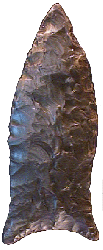



Point Type: BEAVER
LAKE
Also See: Arkabutla, Barber, Bat Cave, Candy
Creek, Cumberland, Dalton, Golondrina, Midland, Pike County, Quad,
Simpson, Suwannee
Location: Midwestern to Eastern United States and Florida
Associated Dates:
11,000 - 8500 B.P. - Paleo
- Early Archaic
Morphology: Auriculate
General Description: The Beaver Lake projectile point is a medium to large sized lanceolate unfluted, blade with flairing basal ears or auricles on the stem base. The basal edges and stem sides are typically ground smooth and the base is concave and is rarely straight. The basal edge often has short basal thinning flakes removed. The blade edges are recurved and constrict towards the base to form an extended stem or hafting area. The Beaver Lake type is comparable to the Cumberland point type but the Beaver Lake totally lacks fluting and specimens typically show only moderate basal thinning. At one time, Beaver Lake points were called Unfluted Cumberland. Beaver Lake points are usually much thinner in cross section that Cumberland points and can have broader width proportions. The Beaver Lake's cross section is typically biconvex, sometimes with a median ridge exhibited on one or both blade faces.
The Beaver Lake points were knapped with a combination of controlled percussion and pressure flaking techniques. They have a late Paleo-Indian affiliation and are considered part of the Dalton Cluster of projectile points. Beaver Lake points are rare but do occur throughout the Tennessee River Valley in northern Alabama, northeastern Mississippi, Tennessee, Kentucky and Missouri. They can sporadically occur over much of the South since Beaver Lake points have been identified from northern Florida, South Carolina, North Carolina and Georgia. A few points have been recovered in the Ohio Valley from Illinois, southern Indiana, West Virginia and Ohio.
The size of Beaver Lake point can range from 45 mm to 86 mm in length. The average size is 64 mm in length, with a typical width of 24 mm. Thickness averages 8 mm. The type has been called the Unfluted Cumberland in some papers. The point was named in 1962 by David L. DeJarnette, James W. Cambron, David C. Hulse and Edward B. Kurjack for examples that were recovered from the Stanfield-Whorley Bluff Shelter, Colbert County, Alabama. It was named for the the Beaver Lake area of Limestone County, Alabama.
About the Point Above (Left): The large point pictured at the top left of this page, was found in Meade County, Kentucky. The point is made from a glossy dark chocolate colored flint that has light caramel colored flint inclusions on the outer edges of the blade, especially near the tip. Overall, the point measures 73 mm in length, is 28 mm wide (across the auricles) and is only 6 mm thick in mid blade. The concavity of the base is 4 mm deep. The base is ground as are the ears and blade edges running 21 mm up from the ears of the base. The hafting area is 24 mm wide and the width across the widest part of the blade is 26 mm. Catalog Number 189E-250-L
About the Point Above (Right): The small point pictured at the top right of this page, was found in outside the town of New Hope, Madison County, Alabama in a creek bank. The point is made from a highly patinated light chocolate colored flint. Overall, the point measures 46 mm in length, is 23 mm wide (across the auricles) and is 7 mm thick in mid blade. The concavity of the base is 1.5 mm deep. The base is ground as are the ears and blade edges running 20 mm up from the ears of the base. The hafting area is 21 mm wide and the width across the widest part of the blade is 23 mm. Catalog Number 134-20-D
References: Baker, Cambron & Hulse, Dragoo (a, d), Justice, Overstreet, Perino (1, 3), Powell, Puckett (1), Sowell & Nowak, Waldorf
© Copyright 1997 - 2008 LITHICS-Net WWW.LITHICSNET.COM
Use Your Browser's BACK Button to Return to the LITHICS-Net Index.